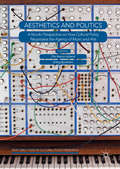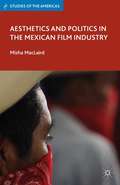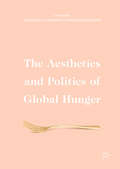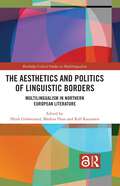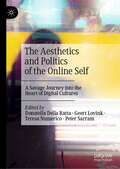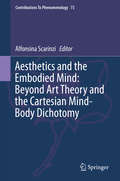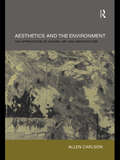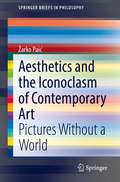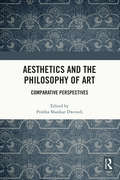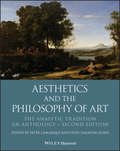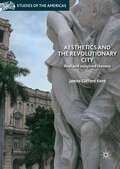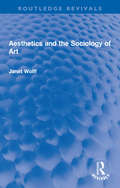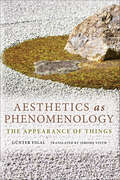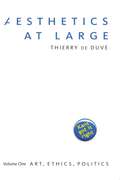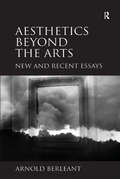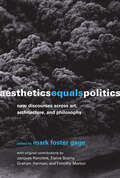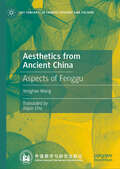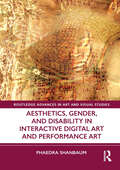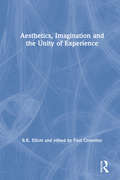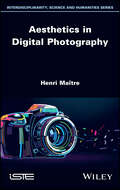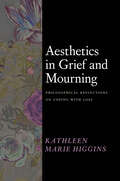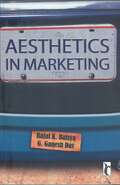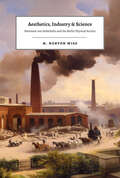- Table View
- List View
Aesthetics and Politics: A Nordic Perspective on How Cultural Policy Negotiates the Agency of Music and Arts (New Directions in Cultural Policy Research)
by Ole Marius Hylland Erling BjurströmThrough comparative and integrated case studies, this book demonstrates how aesthetics becomes politics in cultural policy. Contributors from Norway, Sweden and the UK analyse exactly what happens when art is considered relevant for societal development, at both a practical and theoretical level. Cultural policy is seen here as a mechanism for translating values, that through organized and practical aesthetical judgement lend different forms of agency to the arts. What happens when aesthetical value is reinterpreted as political value? What kinds of negotiations take place at a cultural policy ground level when values are translated and reinterpreted? By addressing these questions, the editors present an original collection that effectively centralises and investigates the role of aesthetics in cultural policy research.
Aesthetics and Politics in the Mexican Film Industry
by Misha MaclairdAesthetics and Politics in the Mexican Film Industry is the first English-language analysis of what some called a "renaissance" at the turn of the twenty-first century. It examines the years surrounding Mexicos presidential elections in 2000 and the fall of the ruling party after seventy one years in power in order to better understand a moment when politics and cinema shared the limelight. Moving beyond the international blockbusters, the research evaluates a broad selection of films, produced from the early 1990s to the present, to help demystify this period for scholars and students. It explains in clear language how production methods, audience demographics, and aesthetic approaches have changed throughout the past two decades of Mexican cinema and how these changes relate to Mexico's transitions to a democratic political system and free-market economy. "
The Aesthetics and Politics of Global Hunger
by Anastasia Ulanowicz Manisha BasuThis collection investigates modern imperialist practices and their management of hunger through its punctuated distribution amongst asymmetrically related marginal populations. Drawing on relevant material from Egypt, Ireland, India, Ukraine, and other regions of the globe, The Aesthetics and Politics of Global Hunger is a rigorously comparative study made up of ten essays by well-established scholars from universities around the world. <P><P>Since modernity, we have been inhabitants of a globe increasingly connected through discourses of equal access for all humans to the resources of the planet, but the volume emphasizes alongside this reality the flagrant politicization of those same resources. <P>From this emphasis, the essays in the volume place into relief the idea that ideological and aesthetic discourses of hunger could inform ethical thinking and practices about who or what constitutes the figure of the modern historical human.
The Aesthetics and Politics of Linguistic Borders: Multilingualism in Northern European Literature (Routledge Critical Studies in Multilingualism)
by Heidi Grönstrand Markus Huss Ralf KauranenThis collection showcases a multivalent approach to the study of literary multilingualism, embodied in contemporary Nordic literature. While previous approaches to literary multilingualism have tended to take a textual or authorship focus, this book advocates for a theoretical perspective which reflects the multiplicity of languages in use in contemporary literature emerging from increased globalization and transnational interaction. Drawing on a multimodal range of examples from contemporary Nordic literature, these eighteen chapters illustrate the ways in which multilingualism is dynamic rather than fixed, resulting from the interactions between authors, texts, and readers as well as between literary and socio-political institutions. The book highlights the processes by which borders are formed within the production, circulation, and reception of literature and in turn, the impact of these borders on issues around cultural, linguistic, and national belonging. Introducing an innovative approach to the study of multilingualism in literature, this collection will be of particular interest to students and researchers in literary studies, cultural studies, and multilingualism.
The Aesthetics and Politics of Linguistic Borders: Multilingualism in Northern European Literature (ISSN)
by Markus Huss Ralf KauranenThis collection showcases a multivalent approach to the study of literary multilingualism, embodied in contemporary Nordic literature. While previous approaches to literary multilingualism have tended to take a textual or authorship focus, this book advocates for a theoretical perspective which reflects the multiplicity of languages in use in contemporary literature emerging from increased globalization and transnational interaction. Drawing on a multimodal range of examples from contemporary Nordic literature, these eighteen chapters illustrate the ways in which multilingualism is dynamic rather than fixed, resulting from the interactions between authors, texts, and readers as well as between literary and socio-political institutions. The book highlights the processes by which borders are formed within the production, circulation, and reception of literature and in turn, the impact of these borders on issues around cultural, linguistic, and national belonging. Introducing an innovative approach to the study of multilingualism in literature, this collection will be of particular interest to students and researchers in literary studies, cultural studies, and multilingualism.
The Aesthetics and Politics of the Online Self: A Savage Journey into the Heart of Digital Cultures
by Donatella Della Ratta Geert Lovink Teresa Numerico Peter SarramThis volume investigates our dissonant and exuberant existences online. As social media users we know we’re under surveillance, yet we continue to click, like, love and share ourselves online as if nothing was. So, how do we overcome the current online identity regime? Can we overthrow the rule of Narcissus and destroy the planetary middle class subject? In this catalogue of strategies, the reader will find stories on hacker groups, gaming platforms in the occupied territories, art objects, selfies, augmented reality, Gen Z autoethnographies, love and life. The authors of this anthology believe we cannot simply put vanity aside and a rational analysis of platform capitalism is not going to convince the youngs on TikTok nor liberate us from Zuckerbergian indentured servitude. Do we really need to wade through the subjective mud and ‘learn more’ about online aesthetics? The answer is yes.Writing by Wendy Chun, Franco Berardi “BIFO”, Julia Preisker, Katherine Behar, Rebecca Stein, Fabio Cristiano, Emilio Distretti, Natalie Bookchin, Ana Peraica, Mitra Azar, Donatella Della Ratta, Gabriella Coleman, Marco Deseriis, Alberto Micali, Daniel de Zeeuw, Giovanni Boccia Artieri, Jodi Dean.
Aesthetics and Technology in Building: The Twenty-First-Century Edition
by Pier Nervi Cristiana Chiorino Elisabetta Nervi Thomas LeslieThe UNESCO headquarters in Paris. The Pirelli skyscraper in Milan. The Palazetto dello Sport in Rome. The "soaring beauty" of Pier Luigi Nervi's visionary designs and buildings changed cityscapes in the twentieth century. His uncanny ingenuity with reinforced concrete, combined with a gift for practical problem solving, revolutionized the use of open internal space in structures like arenas and concert halls. Aesthetics and Technology in Building: The Twenty-First-Century Edition introduces Nervi's ideas about architecture and engineering to a new generation of students and admirers. More than 200 photographs, details, drawings, and plans show how Nervi put his ideas into practice. Expanding on the seminal 1961 Norton Lectures at Harvard, Nervi analyzes various functional and construction problems. He also explains how precast and cast-in-place concrete can answer demands for economy, technical and functional soundness, and aesthetic perfection. Throughout, he uses his major projects to show how these now-iconic buildings emerged from structural truths and far-sighted construction processes. This new edition features dozens of added images, a new introduction, and essays by Joseph Abram, Robert Einaudi, Alberto Bologna, and Gabriele Neri on Nervi's life, work, and legacy.
Aesthetics and the Embodied Mind: Beyond Art Theory and the Cartesian Mind-Body Dichotomy (Contributions To Phenomenology #73)
by Alfonsina ScarinziThe project of naturalizing human consciousness/experience has made great technical strides (e. g. , in mapping areas of brain activity), but has been hampered in many cases by its uncritical reliance on a dualistic "Cartesian" paradigm (though as some of the authors in the collection point out, assumptions drawn from Plato and from Kant also play a role). The present volume proposes a version of naturalism in aesthetics drawn from American pragmatism (above all from Dewey, but also from James and Peirce)--one primed from the start to see human beings not only as embodied, but as inseparable from the environment they interact with--and provides a forum for authors from diverse disciplines to address specific scientific and philosophical issues within the anti-dualistic framework considering aesthetic experience as a process of embodied meaning-making. Cross-disciplinary contributions come from leading researchers including Mark Johnson, Jim Garrison, Daniel D. Hutto, John T. Haworth, Luca F. Ticini, Beatriz Calvo-Merino. The volume covers pragmatist aesthetics, neuroaesthetics, enactive cognitive science, literary studies, psychology of aesthetics, art and design, sociology.
Aesthetics and the Environment: The Appreciation of Nature, Art and Architecture
by Allen CarlsonTraditional aesthetics is often associated with the appreciation of art, Allen Carlson shows how much of our aesthetic experience does not encompass art but nature, in our response to sunsets, mountains or horizons or more mundane surroundings, like gardens or the view from our window.He argues that knowledge of what it is we are appreciating is essential to having an appropriate aesthetic experience and that scientific understanding of nature can enhance our appreciation of it, rather than denigrate it.
Aesthetics and the Iconoclasm of Contemporary Art: Pictures Without a World (SpringerBriefs in Philosophy)
by Žarko PaićThe main themes and aims of this book are understanding aesthetics, contemporary art and the end of the avant-garde not from the traditional viewpoint of the metaphysics of the beautiful and the sublime but rather thru close connection to the techno-genesis of virtual worlds. This book tackles problems in contemporary art theory such as the body in space and time of digital technologies, along with other issues in visual studies and image science. Further intentions exhibit the fundamental reasons for the disappearance of the picture in the era of virtual reality starting from the notion of contemporary art as realized iconoclasm; art has no world for its "image". The author argues that the iconoclasm of contemporary art has severe consequences. This text appeals to philosophers of art and those interested in contemporary art theory.
Aesthetics and the Philosophy of Art: Comparative Perspectives
by Prabha Shankar DwivediThis volume brings together the finest research on aesthetics and the philosophy of art by stalwart critics and leading scholars in the field. It discusses various themes, such as the idea of aesthetic perception, the nature of aesthetic experience, attitude theory, the relation of art to morality, representation in art, and the association of aesthetics with language studies in the Indian tradition. It deliberates over the theories and views of Aristotle, Freud, Plato, Immanuel Kant, T. S. Eliot, George Dickie, Leo Tolstoy, R. G. Collingwood, Michael H. Mitias, Monroe C. Beardsley, and Abhinavagupta, among others. The book offers a comparative perspective on Indian and Western approaches to the study of art and aesthetics and enables readers to appreciate the similarities and differences between the conceptions of aesthetics and philosophy of art on a comparative scale detailing various aspects of both. The first of its kind, this key text will be useful for scholars and researchers of arts and aesthetics, philosophy of art, cultural studies, comparative literature, and philosophy in general. It will also appeal to general readers interested in the philosophy of art.
Aesthetics and the Philosophy of Art: The Analytic Tradition, An Anthology (Blackwell Philosophy Anthologies)
by Peter Lamarque Stein Haugom OlsenFor over fifty years, philosophers working within the broader remit of analytic philosophy have developed and refined a substantial body of work in aesthetics and the philosophy of art, curating a core foundation of scholarship which offers rigor and clarity on matters of profound and perennial interest relating to art and all forms of aesthetic appreciation. Now in its second edition and thoroughly revised, Aesthetics and the Philosophy of Art—The Analytic Tradition: An Anthology captures this legacy in a comprehensive introduction to the core philosophical questions and conversations in aesthetics. Through 57 key essays selected by leading scholars Peter Lamarque and Stein Haugom Olsen, this anthology collects modern classics as well as new contributions on essential topics such as the identification and ontology of art, interpretation, values of art, art and knowledge, and fiction and the imagination. New to this edition are selections which treat aesthetic experience more widely, including essays on the aesthetics of nature and aesthetics in everyday life. Other carefully-chosen pieces analyze the practice and experience of specific art forms in greater detail, including painting, photography, film, literature, music, and popular art such as comics. This bestselling collection is an essential resource for students and scholars of aesthetics, designed to foster a foundational understanding of both long-standing and contemporary topics in the field.
Aesthetics and the Revolutionary City: Real and Imagined Havana (Studies of the Americas)
by James Clifford KentAesthetics and the Revolutionary City engages in alternative ways of reading foreign visual representations of Havana through analysis of advertising images, documentary films, and photographic texts. It explores key narratives relating to the projection of different Havana imaginaries and focuses on a range of themes including: pre-revolutionary Cuba; the dream of revolution; and the metaphor of the city “frozen-in-time.” The book also synthesizes contemporary debates regarding the notion of Havana as a real and imagined city space and fleshes out its theoretical insights with a series of stand-alone, important case studies linked to the representation of the Cuban capital in the Western imaginary. The interpretations in the book bring into focus a range of critical historical moments in Cuban history (including the Cuban Revolution and the “Special Period”) and consider the ways in which they have been projected in advertising, documentary film and photography outside the island.
Aesthetics and the Sociology of Art (Routledge Revivals)
by Janet WolffFirst published in 1983, Aesthetics and the Sociology of Art provides a lucid account of two divergent tendencies in the study of aesthetics. At the one extreme, traditional aestheticians have assumed that art and literature are wholly independent, following only the laws and inspirations of artists and artistic movements, and that the question of aesthetic value is accordingly unproblematic. At the other extreme, some sociologists have treated works of art as no more than manifestations of the socio-economic circumstances which produce them, arguing that aesthetic value is therefore entirely relative matter. Janet Wolff shows how both the extreme positions are untenable, and argues convincingly that we must accept that the conceptions and criteria of aesthetic value are socially constructed and inevitably ideological, while stopping short of the reductionist alternative which fails to recognise the irreducible questions of pleasure and of aesthetic discourse. This book provides an invaluably clear guide both to old debates and to otherwise obscure modern controversies, which will be welcomed both by students and scholars in the sociology of art, in aesthetics, in art history, and in literary criticism.
Aesthetics as Phenomenology: The Appearance of Things (Studies in Continental Thought)
by Günter FigalConnecting aesthetic experience with our experience of nature or with other cultural artifacts, Aesthetics as Phenomenology focuses on what art means for cognition, recognition, and affect—how art changes our everyday disposition or behavior. Günter Figal engages in a penetrating analysis of the moment at which, in our contemplation of a work of art, reaction and thought confront each other. For those trained in the visual arts and for more casual viewers, Figal unmasks art as a decentering experience that opens further possibilities for understanding our lives and our world.
Aesthetics at Large: Volume 1: Art, Ethics, Politics (Art, Ethics, Politics)
by Thierry de DuveImmanuel Kant’s Critique of Judgment, Thierry de Duve argues in the first volume of Aesthetics at Large, is as relevant to the appreciation of art today as it was to the enjoyment of beautiful nature in 1790. Going against the grain of all aesthetic theories situated in the Hegelian tradition, this provocative thesis, which already guided de Duve’s groundbreaking book Kant After Duchamp (1996), is here pursued in order to demonstrate that far from confining aesthetics to a stifling formalism isolated from all worldly concerns, Kant’s guidance urgently opens the understanding of art onto ethics and politics. Central to de Duve’s re-reading of the Critique of Judgment is Kant’s idea of sensus communis, ultimately interpreted as the mere yet necessary idea that human beings are capable of living in peace with one another. De Duve pushes Kant’s skepticism to its limits by submitting the idea of sensus communis to various tests leading to questions such as: Do artists speak on behalf of all of us? Is art the transcendental ground of democracy? Or, Was Adorno right when he claimed that no poetry could be written after Auschwitz? Loaded with de Duve’s trademark blend of wit and erudition and written without jargon, these essays radically renew current approaches to some of the most burning issues raised by modern and contemporary art. They are indispensable reading for anyone with a deep interest in art, art history, or philosophical aesthetics.
Aesthetics beyond the Arts: New and Recent Essays
by Arnold BerleantTaking the view that aesthetics is a study grounded in perception, the essays in this volume exhibit many sides of the perceptual complex that is the aesthetic field and develop them in different ways. They reinvigorate our understanding of such arts as music and architecture; they range across the natural landscape to the urban one; they reassess the place of beauty in the modern environment and reassess the significance of the contributions to aesthetic theory of Kant and Dewey; and they broach the kinds of meanings and larger understanding that aesthetic engagement with the human environment can offer. Written over the past decade, these original and innovative essays lead to a fresh encounter with the possibilities of aesthetic experience, one which has constantly evolved, moving in recent years in the direction of what Berleant terms 'social aesthetics', which enhances human-environmental integration and sociality.
Aesthetics Equals Politics: New Discourses across Art, Architecture, and Philosophy (The\mit Press Ser.)
by Mark Foster Gage Matt ShawHow aesthetics—understood as a more encompassing framework for human activity—might become the primary discourse for political and social engagement.These essays make the case for a reignited understanding of aesthetics—one that casts aesthetics not as illusory, subjective, or superficial, but as a more encompassing framework for human activity. Such an aesthetics, the contributors suggest, could become the primary discourse for political and social engagement. Departing from the “critical” stance of twentieth-century artists and theorists who embraced a counter-aesthetic framework for political engagement, this book documents how a broader understanding of aesthetics can offer insights into our relationships not only with objects, spaces, environments, and ecologies, but also with each other and the political structures in which we are all enmeshed. The contributors—philosophers, media theorists, artists, curators, writers and architects including such notable figures as Jacques Rancière, Graham Harman, and Elaine Scarry—build a compelling framework for a new aesthetic discourse. The book opens with a conversation in which Rancière tells the volume's editor, Mark Foster Gage, that the aesthetic is “about the experience of a common world.” The essays following discuss such topics as the perception of reality; abstraction in ethics, epistemology, and aesthetics as the “first philosophy”; Afrofuturism; Xenofeminism; philosophical realism; the productive force of alienation; and the unbearable lightness of current creative discourse.Contributors Mark Foster Gage, Jacques Rancière, Elaine Scarry, Graham Harman, Timothy Morton, Ferda Kolatan, Adam Fure, Michael Young, Nettrice R. Gaskins, Roger Rothman, Diann Bauer, Matt Shaw, Albena Yaneva, Brett Mommersteeg, Lydia Kallipoliti, Ariane Lourie Harrison, Rhett Russo, Peggy Deamer, Caroline PicardMatt Shaw, Managing Editor
Aesthetics from Ancient China: Aspects of Fenggu (Key Concepts in Chinese Thought and Culture)
by Yonghao WangThis book presents the concept of Fenggu, one of the most important aesthetic categories of ancient China. As an inspiring aesthetic principle, it once encapsulated the particularities of various types of artistic creation and played an important role in traditional artistic creation and theoretic critique. The present volume aims to systematically elaborate on its etymological origin, connotations and generation, its great role in overcoming the tendency of creative stereotypes, its logical positioning in the ancient aesthetic system and its profound connection with traditional culture, via comprehensive analysis of a rich repository of original materials, in combination with calligraphy, painting, and poetry criticism. The theoretical character of traditional aesthetics has been derived from agglomeration of Fenggu with other several important categories of paradigm significance. Therefore, its investigation can offer insights into the organic rhythm of the development of ancient aesthetic thought and consequently lay a solid foundation for the construction of ancient art history and aesthetic history.
Aesthetics, Gender, and Disability in Interactive Digital Art and Performance Art (Routledge Advances in Art and Visual Studies)
by Phaedra ShanbaumThis book explores the tensions between aesthetics, gender, and disability in contemporary digital media installations and performance art. Notions of agency and subjectivity are connected to four contemporary political issues (artificial intelligence, migration and political violence, contemporary medical technologies and practices, and the Anthropocene) and analyzed against a Western legacy of utopian and dystopian ideas and desires that have shaped, and continue to shape, what it means to be human. The book’s main argument is that agency and subjectivity are not universal attributes; rather they are socio-material entanglements and contextually bound enactments that are strategically negotiated by the subject. Thus, they involve conflict, struggle, and other forms of resistance.The book will be of interest to scholars working in art history, media and cultural studies, disability studies, and gender studies.
Aesthetics, Imagination and the Unity of Experience
by R.K. Elliott edited by CrowtherThis is the first book to gather together R. K. Elliott's important essays on aesthetics. These essays put forward a number of common themes that together constitute a unified approach to aesthetics. A theory of imagination is developed and ideas concerning the practice of art criticism are explored before the relevance of aesthetics for ethics is discussed. Throughout his writing Elliott combines analytic rigour with sympathy for ideas in continental philosophy. He values subjectivity but his analytic stance prevents this from falling into mere personal opinion; he is also able to show how art and aesthetic theory is of complex relevance to broader areas of experience such as education, freedom, and moral action. In the course of his discussion Elliott offers an in-depth analysis of Kant's Critique of Judgement, Clive Bell's aesthetic theory, and the relevance of Wittgenstein for aesthetics. Study of Elliott's essays presented in this book powerfully illuminates the unifying role of imagination and the aesthetic in human experience.
Aesthetics in Digital Photography
by Henri MaîtreAutomatically evaluating the aesthetic qualities of a photograph is a current challenge for artificial intelligence technologies, yet it is also an opportunity to open up new economic and social possibilities.Aesthetics in Digital Photography presents theories developed over the last 25 centuries by philosophers and art critics, who have sometimes been governed by the objectivity of perception, and other times, of course, by the subjectivity of human judgement. It explores the advances that have been made in neuro-aesthetics and their current limitations.In the field of photography, this book puts aesthetic hypotheses up against experimental verification, and then critically examines attempts to “scientifically” measure this beauty. Special attention is paid to artificial intelligence techniques, taking advantage of machine learning methods and large databases.
Aesthetics in Grief and Mourning: Philosophical Reflections on Coping with Loss
by Kathleen Marie HigginsA philosophical exploration of aesthetic experience during bereavement. In Aesthetics of Grief and Mourning, philosopher Kathleen Marie Higgins reflects on the ways that aesthetics aids people experiencing loss. Some practices related to bereavement, such as funerals, are scripted, but many others are recursive, improvisational, mundane—telling stories, listening to music, and reflecting on art or literature. Higgins shows how these grounding, aesthetic practices can ease the disorienting effects of loss, shedding new light on the importance of aesthetics for personal and communal flourishing.
Aesthetics in Marketing
by Rajat K Baisya G. Ganesh DasA book for Indian designers and brand marketers, Aesthetics in Marketing primarily deals with understanding aesthetics beyond its visual association and making it relevant to product designing strategies. It is the first attempt of its kind to understand the influence of aesthetics in the context of two very important sectors of the industry—consumer durables and automobile. The book analyses various aesthetic attributes, qualities and elements in a product and deliberates on the important of each of these and the kind of balance necessary among them for designing successful products. It stands out on account of the theory, concepts and models discussed, which have a strong foundation in the authors` primary research. Through real-life case studies, interviews, and company and consumer surveys, the authors have brought to the fore the important of aesthetics in various aspects of marketing, like cultivation of a brand image, and have focused on the role played by demographic variables in influencing product buying decisions. Bringing a whole new meaning to the adage `beauty is in the eye of the beholder`, this book will certainly lead to introspection on the importance of `aesthetics` in the market value of a product.
Aesthetics, Industry, and Science: Hermann von Helmholtz and the Berlin Physical Society
by M. Norton WiseOn January 5, 1845, the Prussian cultural minister received a request by a group of six young men to form a new Physical Society in Berlin. In fields from thermodynamics, mechanics, and electromagnetism to animal electricity, ophthalmology, and psychophysics, members of this small but growing group—which soon included Emil Du Bois-Reymond, Ernst Brücke, Werner Siemens, and Hermann von Helmholtz—established leading positions in what only thirty years later had become a new landscape of natural science. How was this possible? How could a bunch of twenty-somethings succeed in seizing the future? In Aesthetics, Industry, and Science M. Norton Wise answers these questions not simply from a technical perspective of theories and practices but with a broader cultural view of what was happening in Berlin at the time. He emphasizes in particular how rapid industrial development, military modernization, and the neoclassical aesthetics of contemporary art informed the ways in which these young men thought. Wise argues that aesthetic sensibility and material aspiration in this period were intimately linked, and he uses these two themes for a final reappraisal of Helmholtz’s early work. Anyone interested in modern German cultural history, or the history of nineteenth-century German science, will be drawn to this landmark book.
